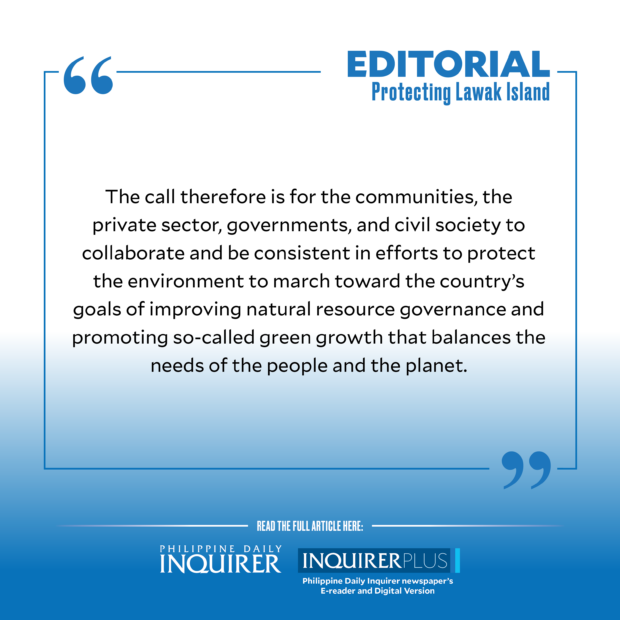Protecting Lawak Island

Valiant efforts by the remote municipality of Kalayaan to protect a vital bird sanctuary in the West Philippine Sea (WPS) for the endemic sooty terns and great crested terns and brown noddies have been bolstered by the commitment of the Palawan provincial government to step up protection of the Lawak Island Critical Habitat.
Last week, the Palawan Council for Sustainable Development (PCSD) and the Kalayaan municipal government signed a memorandum of agreement that gave the Kalayaan local government unit the primary responsibility of managing and protecting the island, in partnership with the United States Agency for International Development (USAID) through its “Sustainable Interventions for Biodiversity, Ocean, and Landscapes (Sibol)” project.
Victorino Dennis Socrates, governor of Palawan and chair of PCSD, which is responsible for fostering sustainable growth in the province, underscored that the agreement was just the first of a number of interventions that the province will undertake to not just protect the rich marine environment of the Kalayaan island group—which is part of the Spratly Islands—but to also assert the Philippines’ territorial rights over the WPS.
Philippine Red List
The 7.9-hectare Lawak Island, which lies about 300 kilometers west of Palawan, is the fourth largest of the nine islands and maritime features occupied by the Philippines in the WPS that has seen repeated and increasingly aggressive incursions by the China Coast Guard and Chinese maritime militia vessels as China continues to defy the Philippines’ internationally recognized sovereignty over the area teeming with marine life and natural resources.
As a further demonstration of the Philippines’ sovereign rights over the area, Socrates said that the Palawan government would construct a small tourist port on the island with funds from the Department of Transportation, being careful to not disturb the resident species that are considered vulnerable under the Philippine Red List of Threatened Fauna.
He also revealed plans to construct additional educational facilities in the island with the help of the Department of Education, which is in line with strategy to build more permanent structures in island groups occupied by the Philippines to help patrol the country’s exclusive economic zone.
4,300 migratory birds
“We are doing this to strengthen our claim of ownership and sovereignty in the area,” Socrates stressed.
The Palawan government’s resolve to help assert the country’s rights over the area being contested by China is admirable, so is its commitment to aid the Kalayaan local government in managing Lawak Island, which had been declared a critical habitat by the PCSD in 2022.
But as it does so, the provincial as well as the national governments should not lose sight of the primary purpose of bolstering the management of Lawak Island, which aside from hosting three bird species is a sanctuary to approximately 4,300 migratory birds that travel from the north to as far as the Great Barrier Reef in Australia.
Global biodiversity
“This highlights how integral Palawan is to global ecology and the world’s bird populations. Endangering this critical habitat would have a significant impact on global biodiversity,” said PCSD executive director Teodoro Jose Matta.
Mar Guidote, acting chief of party for the USAID Sibol project, likewise underscored that it was crucial to adopt a balanced approach to managing the socioecological, economic as well as military interests in the critical habitat that hosts multiple species of seagrass, seaweed, and corals that in turn provide life to various fishes.
“The plan of each sector is good, but balance is needed, or not everything may be achieved,” Guidote said.
Environmental crimes
The US had noted when it launched the Sibol project in 2020 that across the Philippine archipelago, millions of people rely on the natural environment from forests to the fisheries for their livelihood, and yet these critical resources are under constant threat from natural disasters, climate change, irresponsible tourism, as well as massive exploitation and what are deemed environmental crimes such as the oil spill last year that threatened the Verde Island marine ecosystem.
The call therefore is for the communities, the private sector, governments, and civil society to collaborate and be consistent in efforts to protect the environment to march toward the country’s goals of improving natural resource governance and promoting so-called green growth that balances the needs of the people and the planet.The national government and local government of Palawan must persist in protecting and preserving the abundant biodiversity we are blessed with, such as the Lawak Island habitat, be it from domestic threats or destructive intrusion of a foreign power.




















